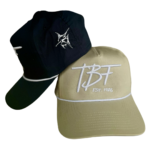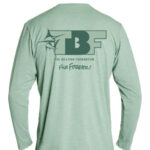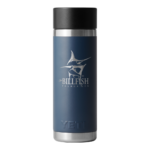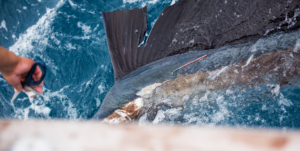
The Tag & Release Program is the cornerstone conservation program of The Billfish Foundation. Created in 1990, it was established to remedy the large gaps in knowledge of billfish life history. As a result, it has created the largest private billfish tagging database in the world, with over 270,000 records.
The Tag & Release Program relies on Captains, anglers, and mates across the world to tag, release, and recapture billfish. It is a global citizen science effort that relies on the collective dedication of thousands of participants. However, it is not enough just to tag or release a billfish. The most important, though often less popular, aspect of the program is reporting.
Reporting your tagged billfish is simple. The orange tag that attaches to the fish’s back comes with an accompanying white card. Both the tag and card have a corresponding six-digit identification number. In this way, if the fish is recaptured, scientists at TBF will be able to match the recaptured fish with the original tagging information, thus closing the scientific loop. If the tag card is never reported, it is as if the tag never happened.
While the white tag card is fairly straight forward, there are a few things that can be tricky to someone new to tagging. Follow this handy guide to learn the do’s and don’ts of billfish tag reporting.
Getting to Know The Tag Card
There are three major sections of the Tag Card. The first is ID & Location, the second is Fish Description, and the third is Fishing Team. Take a look at the card below to familiarize yourself with these three segments. At minimum, every tag card returned must have a species, date, location/GPS, and at least one member of the fishing team listed.
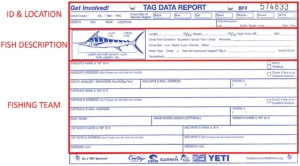
ID & Location
The first section of the tag card identifies the fish and records where and when it was tagged. This is the most important information. If any of this information is missing, the tag report is not usable for research purposes.

- Ocean – Circle the ocean that the fish was tagged in, either Atlantic, Indian, or Pacific. Note that this does not include Gulf of Mexico, Mediterranean Sea, or any other body of water. This is because this information can be included or inferred from later sections and is not necessary to write.
- Species – Draw a checkmark or circle the species of fish tagged. If using TBF cards for tuna, you can simply write the species in this section. Please do not tag fish other than tuna or billfish with TBF tag cards.
- Date – Date is written Month, Day, Year, which is standard for the United States. If you are international, please check that you are writing M/D/Y instead of D/M/Y.
- Location – Location can refer to one of two things – the city/state from which you fish (example: Miami, Florida), or can be a more specific geographic or manmade feature near where you caught the fish (ex. Wilmington Canyon, Ribbon Reef, or Appomattox Rig). If you choose to do the latter, it is important that this is a well-known location, not somewhere that is local knowledge.
- GPS – GPS can be written either hour minute second or as a decimal. You can then circle your hemisphere.
Fish Description
The second section of the tag card is for the details of your fish and the conditions surrounding its capture. The first half focuses on the fish itself and includes length and weight, fight time, and fish condition. There is a handy illustration on the left side that can be used to help you describe the size as accurately as possible. The second half focuses on the fishing conditions and includes bait type, hook type, and tournament.

- Length – Length can be reported in inches or centimeters. Write the nearest whole number of the length on the line, then circle the correct unit of measurement. If you would like to report in feet or meters, simply write in the unit on the line. In the illustration to the left, you can select if the length is for lower jaw fork length or total length and whether it was estimated or measured (with a Release Ruler, against the boat, etc).
- Weight – Weight is reported similarly to length. Just write in your best estimate for the weight on the line, then circle the unit of measurement, either pounds or kilograms. Because tagged fish are necessarily left alive, it is assumed that the weight is an estimated whole weight.
- Fight Time – If you know it, list the fight time here. The first line is for number of hours, the second for number of minutes. Fight time is the amount of time between initial hookup and when the leader is grabbed.
- Fish Condition – Fish Condition refers to the condition that the fish is in at release. The goal should be for the fish to be released in excellent condition after proper revival, preferably without the hook in its mouth. Good or Fair can be used if there is something wrong with the fish – it was released before proper revival, tail wrapped, gut hooked, or some other negative condition. If the fish died after tagging, you may select Dead.
- Bait Type – Select the category of bait used. If you don’t see what you’re looking for, there is a space to write one in. However, note that we do not need to know the exact species of bait fish, size of lure, or any other specific information.
- Hook Type – Circle whether you used circle or J hooks.
- Was fish previously tagged? – This section is used if you recaptured a fish that had a tag in it, removed the tag, and then input a new tag. In this case, you would write the tag number that the fish had originally, not the tag number you’re inputting into the fish. If you recapture a tagged fish, report it to TBF via email at [email protected]. You will receive a special thank-you prize!
- Tournament – This is an optional section. If you tag a fish during a tournament, write the name here. Make sure that you write the name out completely. There are thousands of tournaments across the world, so if you just write an acronym or part of a name, we may not be able to figure out which tournament you mean.
Fishing Team
The final section of the TBF Tag Card gives credit to the team that tagged the fish. Each tag must have at least one person associated with it, meaning that at minimum, this section must include either an angler or a Captain. If the tagged fish is recaptured, only the members of the team listed on this card will receive a prize.
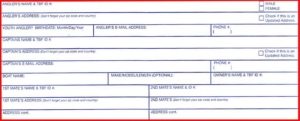
- Angler – The top section is for the angler. The first line asks for full name (first and last) as well as gender. The second line is for mailing address. The third line has three parts. First, you may identify the angler as youth for the Tag & Release Competition. If you are not a youth angler, you do not need to write your birthdate here. The second box is for an email address. Email addresses are the most important part of this section after your name. There are over 150,000 anglers registered in the TBF Tag & Release Database, resulting in many users with the same name. Email addresses are required for us to distinguish you from other users. For example, if three people by the name of Brad Smith send in tag cards, we have no way to know if these are all the same person or three different ones. Only with an email address can we distinguish you, so please include it! The final box is for phone number, should you like to include it.
- Captain – The information for Captain is the same as for angler with one exception. Because there is not a youth Captain category in the Tag & Release Competition, there is no space to write in a birthdate.
- Boat Information – The third section is to write the name of the boat, type of boat, and name of owner. This section helps us credit the correct boats for recaptures and release certificates, in the Tag & Release Competition announcements, and more!
- Mates – The final section is for you to write in the names and addresses of your mates. Please also include your mates’ first AND last name, as well as their email addresses for identification purposes.
Reporting
The last and most important thing to do with a Tag Card is to report it! There are two ways to report a Tag Card. First is to send the physical card to TBF. All Tag Cards are like postcards in that they come with prepaid postage. As long as you’re in the United States, you can just drop them in the mail and they’ll come to us! If you’re international, most people choose to save up their cards until they have a small stack and then send them in an envelope to the address on the card. When you send in your cards, we input them into the database for you. When you send in the tag cards, you can include the completed yellow Tag Issuance card included in your tags. This helps us know who has which tags.
The second way to report your cards is to input them into the database yourself. Go to www.tagbillfish.org and create a profile. There, you can start inputting your own Tag Cards! You’re still welcome to send the cards in to us, as we scan and keep digital copies of each and every Tag Card to ensure that no data is ever lost. Our goal with the Tag & Release Program is to ensure that this important data is used to benefit billfish in as many ways as possible. That’s why, after we scan and save the cards ourselves, we give them to scientists at NOAA Fisheries so that they can do research with that data as well. We also share the data with regulatory bodies like ICCAT and any other researchers that would like to use it – just send us an email at [email protected]!
As you can see, filling out TBF Tag Cards is pretty easy. When you tag a fish and report the data on the Tag Card, you become a part of a global network of anglers, Captains, mates, scientists, managers, and advocates working together to conserve billfish for years to come. Thank you for joining us! If you would like to get involved in the Tag & Release Program, you can purchase tagging equipment at our online shop.

